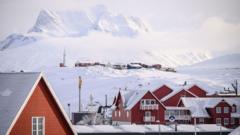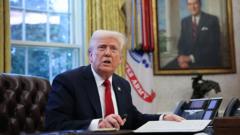The visit has ignited protests and scrutiny from both Greenlanders and Danish officials amidst concerns over US influence in the region.
Greenland Braces for Tensions During US Vice-President's Visit

Greenland Braces for Tensions During US Vice-President's Visit
Vice-President JD Vance's Greenland trip raises eyebrows amid historical context of US territorial ambitions.
In a politically charged atmosphere, Vice-President JD Vance and his wife, Usha, are gearing up for a visit to Greenland that many locals view with skepticism and concern. Scheduled for Friday, the visit coincides with ongoing tensions between the US and Denmark, particularly concerning Greenland's semi-autonomous status and its valuable resources. Originally, Usha Vance intended to travel with her son on a cultural tour that included a dog-sledding race in Nuuk. However, the addition of Vice-President Vance transformed what was meant to be a casual visit into a significant geopolitical episode.
The trip has attracted significant media attention, especially following comments from former President Trump advocating for the acquisition of Greenland, a desire rooted in the island's strategic importance for national security. The involvement of White House National Security Advisor Michael Waltz further amplified concerns, leading to suspicions that the US administration may be attempting to sway local opinions in favor of closer ties with America at the expense of Danish sovereignty.
Greenland’s Acting Prime Minister, Mute B Egede, criticized the visit as a "provocation" and implored the international community to take note of the situation. “For the record, the government of Greenland did not invite this visit, official or private,” Egede reaffirmed, tapping into a growing undercurrent of discontent towards US engagements.
Local sentiment quickly crystallized around organized protests, with residents seeking to convey their displeasure towards the American delegation. Initially slated to engage with the Greenlandic community, plans were swiftly altered to limit the itinerary solely to the Pituffik Space Base—an American military installation—a move praised by Danish officials as a strategic deescalation of the planned visit.
JD Vance, marking his presence as the highest-ranking official to visit Greenland, emphasized on social media the importance of addressing Greenland's long-ignored concerns. “Ignoring Greenland has not just been a disservice to its people, but a detriment to global security as a whole,” he stated. But the unfolding dynamics, criticized by political analysts as devoid of needed charm, starkly illustrate the cautious relationship between Greenland, Denmark, and the United States.
Expectations on the ground are set against the backdrop of international geopolitics, with Greenland positioned as a crucial region in the Arctic, contested by global powers like Russia and China. According to Michael Williams, an expert on international politics, the Trump administration's interest isn't merely a matter of territory but a broader strategy to assert US authority in vital Arctic waterways.
As the Vice-President's visit approaches, both politicians and the general populace brace for implications that could affect future relations and the narrative surrounding Greenland's autonomy and well-being in the global landscape.
The trip has attracted significant media attention, especially following comments from former President Trump advocating for the acquisition of Greenland, a desire rooted in the island's strategic importance for national security. The involvement of White House National Security Advisor Michael Waltz further amplified concerns, leading to suspicions that the US administration may be attempting to sway local opinions in favor of closer ties with America at the expense of Danish sovereignty.
Greenland’s Acting Prime Minister, Mute B Egede, criticized the visit as a "provocation" and implored the international community to take note of the situation. “For the record, the government of Greenland did not invite this visit, official or private,” Egede reaffirmed, tapping into a growing undercurrent of discontent towards US engagements.
Local sentiment quickly crystallized around organized protests, with residents seeking to convey their displeasure towards the American delegation. Initially slated to engage with the Greenlandic community, plans were swiftly altered to limit the itinerary solely to the Pituffik Space Base—an American military installation—a move praised by Danish officials as a strategic deescalation of the planned visit.
JD Vance, marking his presence as the highest-ranking official to visit Greenland, emphasized on social media the importance of addressing Greenland's long-ignored concerns. “Ignoring Greenland has not just been a disservice to its people, but a detriment to global security as a whole,” he stated. But the unfolding dynamics, criticized by political analysts as devoid of needed charm, starkly illustrate the cautious relationship between Greenland, Denmark, and the United States.
Expectations on the ground are set against the backdrop of international geopolitics, with Greenland positioned as a crucial region in the Arctic, contested by global powers like Russia and China. According to Michael Williams, an expert on international politics, the Trump administration's interest isn't merely a matter of territory but a broader strategy to assert US authority in vital Arctic waterways.
As the Vice-President's visit approaches, both politicians and the general populace brace for implications that could affect future relations and the narrative surrounding Greenland's autonomy and well-being in the global landscape.






















